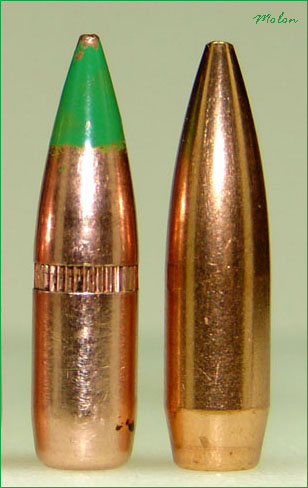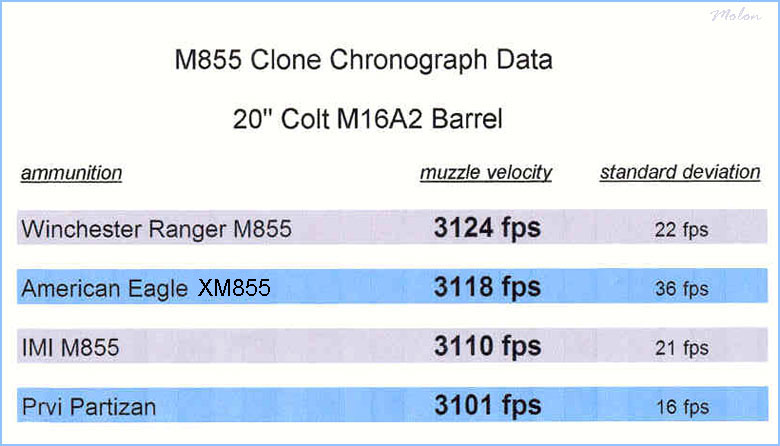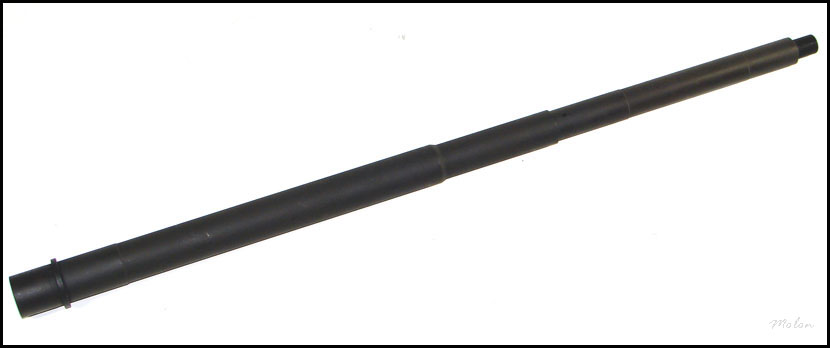

In the first installment of Attack of the (M193) Clones, we examined the velocity and accuracy (technically precision) of four different M193 clones currently available on the commercial market. In part two, well be examining the velocity and accuracy of four different M855 clones currently available on the commercial market. The M855 clones examined for this article are shown below.
IMI M855

Prvi Partizan M855

American Eagle XM855

The obvious difference between the projectiles used in M855 and M193 clones is the weight difference of 7 grains, 62 grains versus 55 grains. The M855 projectile has a FMJ construction but also has a steel penetrator in the ogive section of the bullet. This makes the projectile unusually long for its weight, as well as giving it a lower specific gravity. Most, but not all, of the M855 clones have the tip of the bullet painted green.

Note the steel "penetrator" in the sectioned projectile below.

The M855 projectile is actually longer than the heavier 69 grain Sierra MatchKing.

Chronographing of the M855 clones was conducted as described in part one, using the same 20 M16A2 barrel. The results are shown in the table below.

Accuracy testing of the M855 clones was also conducted exactly as described in part one, using the same free-floated 16 Colt HBAR fired from my bench-rest set-up at 100 yards. As previously stated, I chose a chrome lined, NATO chambered barrel as the accuracy test vehicle as this is the type of barrel that these clone loads are most likely to be fired from.
It is sometimes possible to obtain slightly better accuracy from mil-spec/NATO pressure loads by firing them from an AR-15 that has a stainless steel match-grade barrel with a hybrid chamber such as the Noveske NMmod0 chamber or the 223 Wylde chamber for examples; but you're not going to make a silk purse out of a sows ear doing this.
Three 10-shot groups of each load were fired in a row with the results shown in the table below.

Here are the previous accuracy results of the M193 clones along with the M855 clone results for comparison.

This test will compare the accuracy (technically, precision) of M855, produced by Israel Military Industries (IMI), when fired from an AR-15 with a chrome-lined, NATO chambered barrel with a 1:9 twist and an AR-15 with a chrome-lined, NATO chambered barrel with a 1:7 twist. The IMI M855 is the most consistently accurate loading of all the M855 clones that I have tested to date.
IMI M855 is loaded with a 62 grain FMJ bullet with a cannelure. It also has a steel penetrator seated in the ogive portion of the projectile. This makes the projectile unusually long for its weight, as well as giving it a lower specific gravity. The ammunition is charged with "ball powder". The primers are sealed and crimped in placed. The bullet is also crimped in place and the case mouth is sealed with an asphalt sealant.

Chronograph
data for the IMI M855 was obtained using an Oehler 35P with "proof
screen" technology. All velocities listed are muzzle velocities as
calculated from instrumental velocities using Oehler's Ballistic
Explorer software program. All strings of fire consisted of 10 shots
each.
This
accuracy evaluation used statistically significant shot-group sizes and
every single shot in a fired group was included in the measurements.
There was absolutely no use of any group reduction techniques (e.g.
fliers, target movement, Butterfly Shots).
The shooting set-up will be described in detail below. As many of the significant variables as was practicable were controlled for. Also, control-groups were fired from the barrels used in the evaluation using match-grade, hand-loaded ammunition; in order to demonstrate the capability of the barrels.
All shooting was conducted from a concrete
bench-rest from a distance of 100 yards (confirmed with a laser
rangefinder.) The barrels used in the evaluation were free-floated. The
free-float handguard of the rifle rested in a Sinclair Windage Benchrest
with the aid of a Sinclair fore-arm adaptor, while the stock of the
rifle rested in a Protektor bunny-ear rear bag. Sighting was
accomplished via a Leupold VARI-X III set at 25X magnification and
adjusted to be parallax-free at 100 yards. A mirage shade was attached
to the objective-bell of the scope. Wind conditions on the shooting
range were continuously monitored using a Wind Probe. All rounds were
fired from the magazine. Each upper was fired using the same lower. The
set-up was very similar to that pictured below.
The
barrels used in this evaluation were both Colt HBARs with NATO chambers
and chrome lining. The 1:7 twist barrel was 20 in length and the 1:9
twist barrel was 16 in length. When fired from the 16 barrel with a
1:9 twist, the M855 projectile will have a gyroscopic-stability-factor
of approximately 1.24 and when fired from the 20 barrel with a 1:7
twist the gyroscopic-stability-factor will be approximately 2.07. I
purposely selected the shorter barrel with a 1:9" twist and the longer
barrel with the 1:7" twist in order to exacerbate any possible
statistically significant influence that the differing twist rates might
have on the precision of the M855 ammunition.
Colt 16" HBAR

Colt 20" HBAR

Prior
to the firing of the M855, control groups were fired from the test
barrels using match-grade handloads seated with Sierra 55 grain
BlitzKings. The 10-shot control group fired from the 1:7 twist barrel
had an extreme spread of 1.17 and the 10-shot control group fired from
the 1:9 twist barrel had an extreme spread of 0.89.
Three 10-shot groups were fired from the upper with the 1:9 twist barrel in the manner described above. The extreme spreads for those groups measured:
for a 10-shot group average of 2.38". The three 10-shot groups were over-layed on each other using RSI Shooting Lab to form a 30-shot composite group. The mean radius for the composite group was 0.76.
In the same manner as above, three 10-shot groups were fired from the upper with the 1:7 twist barrel. The extreme spreads of those groups measured:
for a 10-shot group average of 2.29. As before, the three 10-shot groups were over-layed on each other using RSI Shooting Lab to form a 30-shot composite group. The mean radius for this composite group was 0.68.